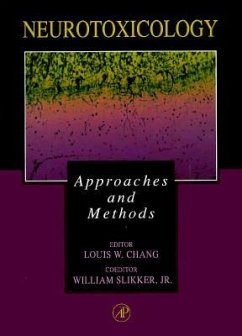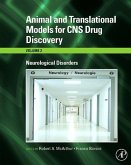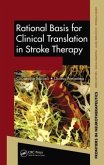Louis W. Chang / Slikker, Jr., William (eds.)Approaches and Methods
Neurotoxicology
Approaches and Methods
Herausgeber: Chang, Louis W; Slikker Jr, William
Louis W. Chang / Slikker, Jr., William (eds.)Approaches and Methods
Neurotoxicology
Approaches and Methods
Herausgeber: Chang, Louis W; Slikker Jr, William
- Gebundenes Buch
- Merkliste
- Auf die Merkliste
- Bewerten Bewerten
- Teilen
- Produkt teilen
- Produkterinnerung
- Produkterinnerung
Neurotoxicology: Approaches and Methods is a unique and comprehensive presentation of the current concepts and state-of-the-art methods for the assessment of neurotoxicity and for the understanding of the toxic mechanisms of many neurotoxicants. The book analyzes various techniques available and discusses their strengths and weaknesses. This volume will serve as an excellent desk companion and laboratory guide for all investigators, researches, clinicians, and students interested in neurotoxicology.
Andere Kunden interessierten sich auch für
![Animal and Translational Models for CNS Drug Discovery: Neurological Disorders Animal and Translational Models for CNS Drug Discovery: Neurological Disorders]() Animal and Translational Models for CNS Drug Discovery: Neurological Disorders112,99 €
Animal and Translational Models for CNS Drug Discovery: Neurological Disorders112,99 €![Animal and Translational Models for CNS Drug Discovery: Reward Deficit Disorders Animal and Translational Models for CNS Drug Discovery: Reward Deficit Disorders]() Animal and Translational Models for CNS Drug Discovery: Reward Deficit Disorders112,99 €
Animal and Translational Models for CNS Drug Discovery: Reward Deficit Disorders112,99 €![Rational Basis for Clinical Translation in Stroke Therapy Rational Basis for Clinical Translation in Stroke Therapy]() Rational Basis for Clinical Translation in Stroke Therapy285,99 €
Rational Basis for Clinical Translation in Stroke Therapy285,99 €![In Vitro Toxicity Testing of Environmental Agents In Vitro Toxicity Testing of Environmental Agents]() Alan R. KolberIn Vitro Toxicity Testing of Environmental Agents159,99 €
Alan R. KolberIn Vitro Toxicity Testing of Environmental Agents159,99 €![Buprenorphine Buprenorphine]() Alan Cowan / John W. Lewis (Hgg.)Buprenorphine343,99 €
Alan Cowan / John W. Lewis (Hgg.)Buprenorphine343,99 €![Mineral and Metal Neurotoxicology Mineral and Metal Neurotoxicology]() Masayuki YasuiMineral and Metal Neurotoxicology270,99 €
Masayuki YasuiMineral and Metal Neurotoxicology270,99 €![In Vitro Neurotoxicology In Vitro Neurotoxicology]() In Vitro Neurotoxicology117,99 €
In Vitro Neurotoxicology117,99 €-
-
-
Neurotoxicology: Approaches and Methods is a unique and comprehensive presentation of the current concepts and state-of-the-art methods for the assessment of neurotoxicity and for the understanding of the toxic mechanisms of many neurotoxicants. The book analyzes various techniques available and discusses their strengths and weaknesses. This volume will serve as an excellent desk companion and laboratory guide for all investigators, researches, clinicians, and students interested in neurotoxicology.
Hinweis: Dieser Artikel kann nur an eine deutsche Lieferadresse ausgeliefert werden.
Hinweis: Dieser Artikel kann nur an eine deutsche Lieferadresse ausgeliefert werden.
Produktdetails
- Produktdetails
- Verlag: Elsevier Science
- Seitenzahl: 851
- Erscheinungstermin: 29. März 1995
- Englisch
- Abmessung: 288mm x 223mm x 42mm
- Gewicht: 2259g
- ISBN-13: 9780121680558
- ISBN-10: 012168055X
- Artikelnr.: 21220962
- Herstellerkennzeichnung
- Libri GmbH
- Europaallee 1
- 36244 Bad Hersfeld
- gpsr@libri.de
- Verlag: Elsevier Science
- Seitenzahl: 851
- Erscheinungstermin: 29. März 1995
- Englisch
- Abmessung: 288mm x 223mm x 42mm
- Gewicht: 2259g
- ISBN-13: 9780121680558
- ISBN-10: 012168055X
- Artikelnr.: 21220962
- Herstellerkennzeichnung
- Libri GmbH
- Europaallee 1
- 36244 Bad Hersfeld
- gpsr@libri.de
Louis W. Chang is a Professor in the Departments of Pathology, Pharmacology, and Toxicology at the University of Arkansas for Medical Sciences. He also served as the Director of the Toxicology Program and is the current Graduate Director of the Pathology Program in Arkansas. Aside from being the author of over 200 scientific articles, Dr. Chang also served on the editorial boards for a number of publications and scientific journals in his field. He is a well recognized scientist internationally. Dr. Chang has been recently elected as a Fellow of the Academy of Toxicological Sciences and has become a board certified Diplomate of the American Board of Forensic Examiners and a Diplomate of the American Board of Forensic Medicine. He received his B.A. from the University of Massachusetts, Amherst, his M.S. in Anatomy and Histochemistry from the Tufts University School of Medicine, and his Ph.D. in Pathology from the University of Wisconsin, Madison Medical School. Dr. Chang also received education and training from Harvard Medical School and the University of California, Los Angeles School of Medicine.
William Slikker, Jr. is currently Director, Division of Neurotoxicology, National Center for Toxicological Research, Food and Drug Administration. He is also Adjunct Professor at the University of Arkansas for Medical Sciences in the Departments of Pediatrics and Pharmacology and Toxicology, and at the University of Tennessee in the Department of Medicinal Chemistry. Dr. Slikker received his B.S. in Biology from the University of California at Santa Barbara, and his Ph.D. in Pharmacology and Toxicology from the University of California at Davis. Dr. Slikker has co-authored over 200 publications in the areas of pharmacokinetics, developmental toxicology, neurotoxicology, and risk assessment. He also serves on the editorial boards for a number of publications in his field.
William Slikker, Jr. is currently Director, Division of Neurotoxicology, National Center for Toxicological Research, Food and Drug Administration. He is also Adjunct Professor at the University of Arkansas for Medical Sciences in the Departments of Pediatrics and Pharmacology and Toxicology, and at the University of Tennessee in the Department of Medicinal Chemistry. Dr. Slikker received his B.S. in Biology from the University of California at Santa Barbara, and his Ph.D. in Pharmacology and Toxicology from the University of California at Davis. Dr. Slikker has co-authored over 200 publications in the areas of pharmacokinetics, developmental toxicology, neurotoxicology, and risk assessment. He also serves on the editorial boards for a number of publications in his field.
ANIMAL MODELS: NEUROMORPHOLOGICAL and NEUROPATHOLOGICAL APPROACHS:
Introductory Overview. Selected Histopathological and Histochemical Methods
for Neurotoxicity Assessment. Neuroanatomical Techniques for Labeling
Neurons and Their Utility in Neurotoxicology. Enzyme Histochemical Methods.
Ultrastructural Methods for Neurotoxicology and Neuropathology.
Quantitative Morphometry for Neurotoxicity Assessment. NEUROPHYSIOLOGICAL
APPROACHES and METHODS: Introductory Overview. Electrophysiological
Analysis of Ion Channel Function. Electrophysiological Methods for Analysis
of Effects of Neurotoxicants on Synaptic Transmission. Hippocampal Field
Potentials: A Model System to Characterize Neurotoxicity.
Electrophysiological Analysis of Complex Brain Systems: Sensory Evoked
Potentials and Their Generators. NEUROBEHAVIORAL TOXICOLOGY: Introductory
Overview. Behavioral Screening Tests: P, P, & F. Neurobehavioral Methods
for the Evaluation of Sensory Functions. Motor Function and the Physical
Properties of the Operant: Applications to Screening and Advanced
Techniques. Approaches to Utilizing Aspects of Cognitive Function as
Indicator of Neurotoxicity. Use of Drug Discrimination Learning in
Behavioral Toxicology: Classification and Characterization of Toxins.
Extrapolating Scientific Data from Animals to Humans in Behavioral
Toxicology and Behavioral Pharmacology. Role of Dopaminergic and
Glutametergic Neurotransmitter Systems in Lead-Induced Learning
Impairments. Dopaminergic Bases of Polychlorinated Biphenyl-Induced
Neurotoxicity. Bases of Excitatory Amino Acid System-Related Neurotoxicity.
NEUROCHEMICAL and BIOMOLECULAR APPROACHES: Introductory Overview. Basic
Biochemical Approaches in Neurotoxicity: Assessment of Neurotransmitters
and Neuroreceptors. Biomolecular Approaches to Neurotoxic Hazard
Assessment. Nucleic Acid Hybridization Techniques and Neurotoxicity
Assessment. Application of the Technique of Brain Microdialysis in
Determining the Mechanisms of Action of Neurotoxicants. Combined Electrical
Resistance Method for Cell Volume Measurement and Continuous Perfusion for
the Measurement of the Release of Endogenous Substances: An in VITRO Assay
for Cytotoxicity. Selective Techniques Designed to Evaluate Neurotoxicity:
Electron Probe X-Ray Microanalysis as a Tool for Discerning Mechanisms of
Nerve Injury. Glutamate Receptor-Mediated Neurotoxicity. Assessment of
Neurotoxicity Via Chemical Purturbation of Oxonal Transport. Disruption of
Energy Metabolism and Mitochondrial Function. In VITRO MODELS: IN-VITRO
Toxicology: Introductory Overview. Strategic Approaches to in VITRO
Neurotoxicology. The Use of Serum-Free Aggregating Brain Cell Cultures in
Neurotoxicology. Brain Slice Techniques in Neurotoxicology. Cell Suspension
Techniques in Neurotoxicology. Central Nervous System Glial Cell Cultures
for Neurotoxicological Investigations. Neurotoxicology Studies Utilizing
Schwann Cell-Neuronal Interactions in VITRO. Organotypic Cultures of
Mammalian Nerve Tissues: A Model System for Neurotoxicological
Investigation. Human Neuronal Cell Lines and in VITRO Models. In VITRO
Systems for the Investigation of Calcium Homeostasis and Calcium-Induced
Cell Damage. In VITRO Electrophysiological Studies in Neurotoxicology.
CLINICAL NEUROTOXICOLOGY: Clinical Neurotoxicology: An Introductory
Overview. Basic Principles of Clinical Neurotoxicology. Clinical
Neurotoxicology of Industrial and Agricultural Chemicals. Clincial
Neurotoxicological Concerns on Drugs of Abuse. Clinical Neurotoxic Concerns
on Antineoplastic Agents. Neurotoxins and Neurodegenerative Diseases.
Clinical Approaches to Neurotoxicology: An Overview. The Recognition and
Differentiation of Neurotoxic and Non-Neurotoxic Syndromes. Exposure
Assessment in Clinical Neurotoxicology: Environmental Monitoring and
Biologic Markers. Clinico-Neuropsychological Assessment Methods in
Behavioral Neurotoxicology. Behavioral Neurophysiology: Quantitative
Measures of Sensory Toxicity. Electrophysiological Investigations of Toxic
Neuropathies. Evoked Potential Testing in Clinical Neurotoxicology.
Neuroimaging in Neurotoxicology. RISK ASSESSMENT for NEUROTOXICITY:
Neurotoxicology Risk Assessment: An Overview. Concepts on Quantitative Risk
Assessment of Neurotoxicants. Quantitative Approaches to Risk Assessment in
Neurotoxicology. Use of Biological Markers in the Quantitative Assessment
of Neurotoxic Risk. Developmental Neurotoxicology Risk Assessment. Unique
Dimensions of Neurotoxic Risk Assessment.
Introductory Overview. Selected Histopathological and Histochemical Methods
for Neurotoxicity Assessment. Neuroanatomical Techniques for Labeling
Neurons and Their Utility in Neurotoxicology. Enzyme Histochemical Methods.
Ultrastructural Methods for Neurotoxicology and Neuropathology.
Quantitative Morphometry for Neurotoxicity Assessment. NEUROPHYSIOLOGICAL
APPROACHES and METHODS: Introductory Overview. Electrophysiological
Analysis of Ion Channel Function. Electrophysiological Methods for Analysis
of Effects of Neurotoxicants on Synaptic Transmission. Hippocampal Field
Potentials: A Model System to Characterize Neurotoxicity.
Electrophysiological Analysis of Complex Brain Systems: Sensory Evoked
Potentials and Their Generators. NEUROBEHAVIORAL TOXICOLOGY: Introductory
Overview. Behavioral Screening Tests: P, P, & F. Neurobehavioral Methods
for the Evaluation of Sensory Functions. Motor Function and the Physical
Properties of the Operant: Applications to Screening and Advanced
Techniques. Approaches to Utilizing Aspects of Cognitive Function as
Indicator of Neurotoxicity. Use of Drug Discrimination Learning in
Behavioral Toxicology: Classification and Characterization of Toxins.
Extrapolating Scientific Data from Animals to Humans in Behavioral
Toxicology and Behavioral Pharmacology. Role of Dopaminergic and
Glutametergic Neurotransmitter Systems in Lead-Induced Learning
Impairments. Dopaminergic Bases of Polychlorinated Biphenyl-Induced
Neurotoxicity. Bases of Excitatory Amino Acid System-Related Neurotoxicity.
NEUROCHEMICAL and BIOMOLECULAR APPROACHES: Introductory Overview. Basic
Biochemical Approaches in Neurotoxicity: Assessment of Neurotransmitters
and Neuroreceptors. Biomolecular Approaches to Neurotoxic Hazard
Assessment. Nucleic Acid Hybridization Techniques and Neurotoxicity
Assessment. Application of the Technique of Brain Microdialysis in
Determining the Mechanisms of Action of Neurotoxicants. Combined Electrical
Resistance Method for Cell Volume Measurement and Continuous Perfusion for
the Measurement of the Release of Endogenous Substances: An in VITRO Assay
for Cytotoxicity. Selective Techniques Designed to Evaluate Neurotoxicity:
Electron Probe X-Ray Microanalysis as a Tool for Discerning Mechanisms of
Nerve Injury. Glutamate Receptor-Mediated Neurotoxicity. Assessment of
Neurotoxicity Via Chemical Purturbation of Oxonal Transport. Disruption of
Energy Metabolism and Mitochondrial Function. In VITRO MODELS: IN-VITRO
Toxicology: Introductory Overview. Strategic Approaches to in VITRO
Neurotoxicology. The Use of Serum-Free Aggregating Brain Cell Cultures in
Neurotoxicology. Brain Slice Techniques in Neurotoxicology. Cell Suspension
Techniques in Neurotoxicology. Central Nervous System Glial Cell Cultures
for Neurotoxicological Investigations. Neurotoxicology Studies Utilizing
Schwann Cell-Neuronal Interactions in VITRO. Organotypic Cultures of
Mammalian Nerve Tissues: A Model System for Neurotoxicological
Investigation. Human Neuronal Cell Lines and in VITRO Models. In VITRO
Systems for the Investigation of Calcium Homeostasis and Calcium-Induced
Cell Damage. In VITRO Electrophysiological Studies in Neurotoxicology.
CLINICAL NEUROTOXICOLOGY: Clinical Neurotoxicology: An Introductory
Overview. Basic Principles of Clinical Neurotoxicology. Clinical
Neurotoxicology of Industrial and Agricultural Chemicals. Clincial
Neurotoxicological Concerns on Drugs of Abuse. Clinical Neurotoxic Concerns
on Antineoplastic Agents. Neurotoxins and Neurodegenerative Diseases.
Clinical Approaches to Neurotoxicology: An Overview. The Recognition and
Differentiation of Neurotoxic and Non-Neurotoxic Syndromes. Exposure
Assessment in Clinical Neurotoxicology: Environmental Monitoring and
Biologic Markers. Clinico-Neuropsychological Assessment Methods in
Behavioral Neurotoxicology. Behavioral Neurophysiology: Quantitative
Measures of Sensory Toxicity. Electrophysiological Investigations of Toxic
Neuropathies. Evoked Potential Testing in Clinical Neurotoxicology.
Neuroimaging in Neurotoxicology. RISK ASSESSMENT for NEUROTOXICITY:
Neurotoxicology Risk Assessment: An Overview. Concepts on Quantitative Risk
Assessment of Neurotoxicants. Quantitative Approaches to Risk Assessment in
Neurotoxicology. Use of Biological Markers in the Quantitative Assessment
of Neurotoxic Risk. Developmental Neurotoxicology Risk Assessment. Unique
Dimensions of Neurotoxic Risk Assessment.
ANIMAL MODELS: NEUROMORPHOLOGICAL and NEUROPATHOLOGICAL APPROACHS:
Introductory Overview. Selected Histopathological and Histochemical Methods
for Neurotoxicity Assessment. Neuroanatomical Techniques for Labeling
Neurons and Their Utility in Neurotoxicology. Enzyme Histochemical Methods.
Ultrastructural Methods for Neurotoxicology and Neuropathology.
Quantitative Morphometry for Neurotoxicity Assessment. NEUROPHYSIOLOGICAL
APPROACHES and METHODS: Introductory Overview. Electrophysiological
Analysis of Ion Channel Function. Electrophysiological Methods for Analysis
of Effects of Neurotoxicants on Synaptic Transmission. Hippocampal Field
Potentials: A Model System to Characterize Neurotoxicity.
Electrophysiological Analysis of Complex Brain Systems: Sensory Evoked
Potentials and Their Generators. NEUROBEHAVIORAL TOXICOLOGY: Introductory
Overview. Behavioral Screening Tests: P, P, & F. Neurobehavioral Methods
for the Evaluation of Sensory Functions. Motor Function and the Physical
Properties of the Operant: Applications to Screening and Advanced
Techniques. Approaches to Utilizing Aspects of Cognitive Function as
Indicator of Neurotoxicity. Use of Drug Discrimination Learning in
Behavioral Toxicology: Classification and Characterization of Toxins.
Extrapolating Scientific Data from Animals to Humans in Behavioral
Toxicology and Behavioral Pharmacology. Role of Dopaminergic and
Glutametergic Neurotransmitter Systems in Lead-Induced Learning
Impairments. Dopaminergic Bases of Polychlorinated Biphenyl-Induced
Neurotoxicity. Bases of Excitatory Amino Acid System-Related Neurotoxicity.
NEUROCHEMICAL and BIOMOLECULAR APPROACHES: Introductory Overview. Basic
Biochemical Approaches in Neurotoxicity: Assessment of Neurotransmitters
and Neuroreceptors. Biomolecular Approaches to Neurotoxic Hazard
Assessment. Nucleic Acid Hybridization Techniques and Neurotoxicity
Assessment. Application of the Technique of Brain Microdialysis in
Determining the Mechanisms of Action of Neurotoxicants. Combined Electrical
Resistance Method for Cell Volume Measurement and Continuous Perfusion for
the Measurement of the Release of Endogenous Substances: An in VITRO Assay
for Cytotoxicity. Selective Techniques Designed to Evaluate Neurotoxicity:
Electron Probe X-Ray Microanalysis as a Tool for Discerning Mechanisms of
Nerve Injury. Glutamate Receptor-Mediated Neurotoxicity. Assessment of
Neurotoxicity Via Chemical Purturbation of Oxonal Transport. Disruption of
Energy Metabolism and Mitochondrial Function. In VITRO MODELS: IN-VITRO
Toxicology: Introductory Overview. Strategic Approaches to in VITRO
Neurotoxicology. The Use of Serum-Free Aggregating Brain Cell Cultures in
Neurotoxicology. Brain Slice Techniques in Neurotoxicology. Cell Suspension
Techniques in Neurotoxicology. Central Nervous System Glial Cell Cultures
for Neurotoxicological Investigations. Neurotoxicology Studies Utilizing
Schwann Cell-Neuronal Interactions in VITRO. Organotypic Cultures of
Mammalian Nerve Tissues: A Model System for Neurotoxicological
Investigation. Human Neuronal Cell Lines and in VITRO Models. In VITRO
Systems for the Investigation of Calcium Homeostasis and Calcium-Induced
Cell Damage. In VITRO Electrophysiological Studies in Neurotoxicology.
CLINICAL NEUROTOXICOLOGY: Clinical Neurotoxicology: An Introductory
Overview. Basic Principles of Clinical Neurotoxicology. Clinical
Neurotoxicology of Industrial and Agricultural Chemicals. Clincial
Neurotoxicological Concerns on Drugs of Abuse. Clinical Neurotoxic Concerns
on Antineoplastic Agents. Neurotoxins and Neurodegenerative Diseases.
Clinical Approaches to Neurotoxicology: An Overview. The Recognition and
Differentiation of Neurotoxic and Non-Neurotoxic Syndromes. Exposure
Assessment in Clinical Neurotoxicology: Environmental Monitoring and
Biologic Markers. Clinico-Neuropsychological Assessment Methods in
Behavioral Neurotoxicology. Behavioral Neurophysiology: Quantitative
Measures of Sensory Toxicity. Electrophysiological Investigations of Toxic
Neuropathies. Evoked Potential Testing in Clinical Neurotoxicology.
Neuroimaging in Neurotoxicology. RISK ASSESSMENT for NEUROTOXICITY:
Neurotoxicology Risk Assessment: An Overview. Concepts on Quantitative Risk
Assessment of Neurotoxicants. Quantitative Approaches to Risk Assessment in
Neurotoxicology. Use of Biological Markers in the Quantitative Assessment
of Neurotoxic Risk. Developmental Neurotoxicology Risk Assessment. Unique
Dimensions of Neurotoxic Risk Assessment.
Introductory Overview. Selected Histopathological and Histochemical Methods
for Neurotoxicity Assessment. Neuroanatomical Techniques for Labeling
Neurons and Their Utility in Neurotoxicology. Enzyme Histochemical Methods.
Ultrastructural Methods for Neurotoxicology and Neuropathology.
Quantitative Morphometry for Neurotoxicity Assessment. NEUROPHYSIOLOGICAL
APPROACHES and METHODS: Introductory Overview. Electrophysiological
Analysis of Ion Channel Function. Electrophysiological Methods for Analysis
of Effects of Neurotoxicants on Synaptic Transmission. Hippocampal Field
Potentials: A Model System to Characterize Neurotoxicity.
Electrophysiological Analysis of Complex Brain Systems: Sensory Evoked
Potentials and Their Generators. NEUROBEHAVIORAL TOXICOLOGY: Introductory
Overview. Behavioral Screening Tests: P, P, & F. Neurobehavioral Methods
for the Evaluation of Sensory Functions. Motor Function and the Physical
Properties of the Operant: Applications to Screening and Advanced
Techniques. Approaches to Utilizing Aspects of Cognitive Function as
Indicator of Neurotoxicity. Use of Drug Discrimination Learning in
Behavioral Toxicology: Classification and Characterization of Toxins.
Extrapolating Scientific Data from Animals to Humans in Behavioral
Toxicology and Behavioral Pharmacology. Role of Dopaminergic and
Glutametergic Neurotransmitter Systems in Lead-Induced Learning
Impairments. Dopaminergic Bases of Polychlorinated Biphenyl-Induced
Neurotoxicity. Bases of Excitatory Amino Acid System-Related Neurotoxicity.
NEUROCHEMICAL and BIOMOLECULAR APPROACHES: Introductory Overview. Basic
Biochemical Approaches in Neurotoxicity: Assessment of Neurotransmitters
and Neuroreceptors. Biomolecular Approaches to Neurotoxic Hazard
Assessment. Nucleic Acid Hybridization Techniques and Neurotoxicity
Assessment. Application of the Technique of Brain Microdialysis in
Determining the Mechanisms of Action of Neurotoxicants. Combined Electrical
Resistance Method for Cell Volume Measurement and Continuous Perfusion for
the Measurement of the Release of Endogenous Substances: An in VITRO Assay
for Cytotoxicity. Selective Techniques Designed to Evaluate Neurotoxicity:
Electron Probe X-Ray Microanalysis as a Tool for Discerning Mechanisms of
Nerve Injury. Glutamate Receptor-Mediated Neurotoxicity. Assessment of
Neurotoxicity Via Chemical Purturbation of Oxonal Transport. Disruption of
Energy Metabolism and Mitochondrial Function. In VITRO MODELS: IN-VITRO
Toxicology: Introductory Overview. Strategic Approaches to in VITRO
Neurotoxicology. The Use of Serum-Free Aggregating Brain Cell Cultures in
Neurotoxicology. Brain Slice Techniques in Neurotoxicology. Cell Suspension
Techniques in Neurotoxicology. Central Nervous System Glial Cell Cultures
for Neurotoxicological Investigations. Neurotoxicology Studies Utilizing
Schwann Cell-Neuronal Interactions in VITRO. Organotypic Cultures of
Mammalian Nerve Tissues: A Model System for Neurotoxicological
Investigation. Human Neuronal Cell Lines and in VITRO Models. In VITRO
Systems for the Investigation of Calcium Homeostasis and Calcium-Induced
Cell Damage. In VITRO Electrophysiological Studies in Neurotoxicology.
CLINICAL NEUROTOXICOLOGY: Clinical Neurotoxicology: An Introductory
Overview. Basic Principles of Clinical Neurotoxicology. Clinical
Neurotoxicology of Industrial and Agricultural Chemicals. Clincial
Neurotoxicological Concerns on Drugs of Abuse. Clinical Neurotoxic Concerns
on Antineoplastic Agents. Neurotoxins and Neurodegenerative Diseases.
Clinical Approaches to Neurotoxicology: An Overview. The Recognition and
Differentiation of Neurotoxic and Non-Neurotoxic Syndromes. Exposure
Assessment in Clinical Neurotoxicology: Environmental Monitoring and
Biologic Markers. Clinico-Neuropsychological Assessment Methods in
Behavioral Neurotoxicology. Behavioral Neurophysiology: Quantitative
Measures of Sensory Toxicity. Electrophysiological Investigations of Toxic
Neuropathies. Evoked Potential Testing in Clinical Neurotoxicology.
Neuroimaging in Neurotoxicology. RISK ASSESSMENT for NEUROTOXICITY:
Neurotoxicology Risk Assessment: An Overview. Concepts on Quantitative Risk
Assessment of Neurotoxicants. Quantitative Approaches to Risk Assessment in
Neurotoxicology. Use of Biological Markers in the Quantitative Assessment
of Neurotoxic Risk. Developmental Neurotoxicology Risk Assessment. Unique
Dimensions of Neurotoxic Risk Assessment.








